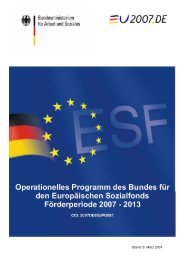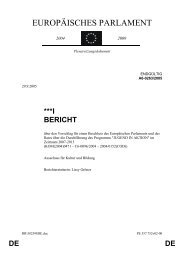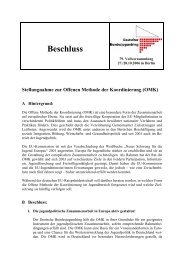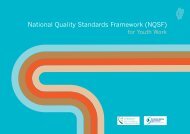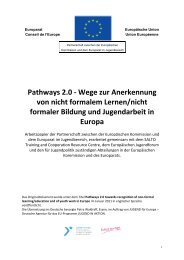Report - Salto
Report - Salto
Report - Salto
Create successful ePaper yourself
Turn your PDF publications into a flip-book with our unique Google optimized e-Paper software.
70<br />
Bridges for Recognition | Hot Issues discussion groups<br />
Strand two: Implementation<br />
1. Formalising the informal: a risk or something to gain from?<br />
One of the institutions that could “recognise” activities from or competences gained in Youth<br />
work is the formal education sector. On occasions, however, it is considered that using fomal<br />
institutions to validate non-formal and informal learning may be inadequate in Youth sectors,<br />
and in particular for some Youth groups (e.g. those who did not well at school may not be thrilled<br />
by the prospect of facing educational institutions again, so that engaging those institutions on<br />
the validation process may actually have detrimental effects). To what extent and under what<br />
conditions is it appropriate to engage formal educational institutions in validation of non-formal<br />
learning in the Youth sector? Moreover, are formal education and training systems prepared<br />
for extensive use of initiatives which validate non-formal and informal learning? Is it likely that<br />
education institutions will collaborate in further inter-linking or oppose it? –E.g. will they see<br />
validation initiatives as “competing” with them in creating and certifying knowledge and skills,<br />
in particular in the context of shrinking age cohorts? Will they also see further inter-linking as a<br />
way to lower standards and therefore oppose it? How could collaboration be facilitated and how<br />
can bridges between the different sectors be created?<br />
2. Standards setting: a framework for quality and legitimacy<br />
In order for validation to be legitimate in the eyes of different stakeholders (employers,<br />
educational institutions, individuals) some kind of standards for validation must be in place –both<br />
for the validation process and the level of competences that are validated. To establish standards<br />
in the Youth field it is necessary to compare the non-formal education process within one Youth<br />
organisation with similar processes in another Youth organisation. But how can this be done,<br />
especially as most skills learned in Youth work are soft-skills? It is difficult to measure how much<br />
young people learn for instance in a Youth Association, sports club or voluntary service using the<br />
traditional criteria and qualifications available, or even job profiles, which are obvious reference<br />
points in standard-setting in the formal learning sector. So what new criteria, reference points or<br />
qualifications should be developed to define competence levels and validation processes of nonformal<br />
and informal learning, and how should these be developed?



